|

Summer
1999 (7.2)
Gorkhmaz Afandiyev
(1928-1993)
Reflections
by his Wife, Bayim Hajiyeva, and Daughter Fovziya
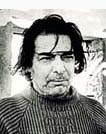  Gorkhmaz Afandiyev's
name is often closely linked with that of his colleague Javad
Mirjavad. As dissident artists, they were known for encouraging
younger artists to follow their own individual paths rather than
adhering to the government-endorsed style of Social Realism.
During a recent interview with Gorkhmaz' wife Bayim Hajiyeva
and daughter Fovziya Afandiyeva, we learned about the personal
tragedy that drove Gorkhmaz to reject the Soviet system and take
such a radical stance. Gorkhmaz Afandiyev's
name is often closely linked with that of his colleague Javad
Mirjavad. As dissident artists, they were known for encouraging
younger artists to follow their own individual paths rather than
adhering to the government-endorsed style of Social Realism.
During a recent interview with Gorkhmaz' wife Bayim Hajiyeva
and daughter Fovziya Afandiyeva, we learned about the personal
tragedy that drove Gorkhmaz to reject the Soviet system and take
such a radical stance.
The men in Gorkhmaz
Afandiyev's family each dedicated their lives to very different
ideals. Gorkhmaz' great-grandfather was a religious man, a Mufti
(chief of the Moslem Sunnite priesthood). Gorkhmaz' father, Sultanmajid
Afandiyev, was one of the top leaders of the Bolshevik Revolution
like Nariman Narimanov and Hamid Sultanzade who helped bring
communism to Azerbaijan and organize a socialist government.
As is well known, the Soviet system did its best to undermine
religious belief and destroy churches and mosques. Fourth-generation
Gorkhmaz, on the other hand, totally disapproved of the Soviet
system that his father had helped establish.
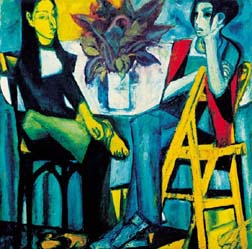  The tragic year of 1937
left indelible scars on Gorkhmaz' art. His father, who had taken
an active part in establishing the Soviet system in Azerbaijan,
became one of its own victims and was killed during Stalin's
Repression that year. Other members of his family, including
his mother, were sent into exile in Siberia. The tragic year of 1937
left indelible scars on Gorkhmaz' art. His father, who had taken
an active part in establishing the Soviet system in Azerbaijan,
became one of its own victims and was killed during Stalin's
Repression that year. Other members of his family, including
his mother, were sent into exile in Siberia.
The three children-Gorkhmaz and his two sisters-were left without
any means of support and spent their childhood living with relatives.
According to his wife Bayim Hajiyeva, who is also an artist,
this was the reason that Gorkhmaz never used bright colors in
his paintings up until his death in 1993.
"That doesn't mean that he was dull by nature. On the contrary,
he was very cheerful and kind. Simply his reminiscences of childhood
and youth had a profound psychological effect on him," she
explains.
Art: Gorkhmaz Afandiyev,
"Adila and Fovziya" (his daughters), 140 x 140 cm,
oil on canvas, 1980.
Deep in his heart, Gorkhmaz never forgave his father for his
Communist principles. He refused to join the Communist Party.
When he was asked to draw his father's portrait, he refused,
though on occasion he did draw Lenin's portrait (even though
it was against his convictions) just to earn money.
Friendship with Javad
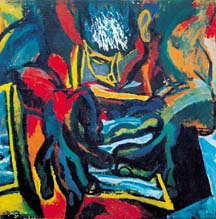  By the time Gorkhmaz
entered the Azim Azimzade Art Institute in Baku in the early
1940s, he was worn out and starving. Javad Mirjavad, a fellow
art student who was five or six years older than Gorkhmaz, took
care of him. Javad took Gorkhmaz to his cottage in Buzovna and
nursed him back to health. By the time Gorkhmaz
entered the Azim Azimzade Art Institute in Baku in the early
1940s, he was worn out and starving. Javad Mirjavad, a fellow
art student who was five or six years older than Gorkhmaz, took
care of him. Javad took Gorkhmaz to his cottage in Buzovna and
nursed him back to health.
Gorkhmaz' daughter Fovziya recalled, "It was a kind of fatherly
love and care that my father never forgot. Despite their disagreements,
he always considered Javad to be his closest friend."
Gorkhmaz and Javad were very influenced by Russian art. They
also studied French art, especially the works of the Impressionists,
rather than the realistic presentation of Social Realism that
the Soviet system strongly endorsed. Gorkhmaz went on to study
in Moscow, then went to Lvov because he found the inclement weather
in Moscow was not good for his health.
Above: Gorkhmaz Afandiyev,
"Searching", 140 x 140 cm, oil on canvas, 1958.
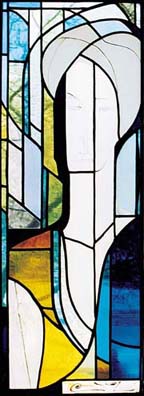 Right:
Fovziya Afandi (Gorkhmaz' daughter) (1963- ), "The Poet
Nasimi", 30 x 90 cm, stained glass, 1987. Right:
Fovziya Afandi (Gorkhmaz' daughter) (1963- ), "The Poet
Nasimi", 30 x 90 cm, stained glass, 1987.
In 1956 he returned
to Baku. Even though Stalin had already died [1953], Gorkhmaz
still found it difficult to find work in Azerbaijan because he
was descended from an "Enemy of the People". He had
offers to work in Russia, but turned them down because he wanted
to remain in Azerbaijan.
Fovziya remembers that her father used to say that art could
not develop and flourish during the Soviet period unless the
official attitude toward art changed. In his opinion, art was
innately symbolic. "When there is no notion about abstraction
in art, it cannot be real art," he used to say. The language
that Gorkhmaz spoke in his art was never understood by Party
members, and his abstract pictures were not accepted for the
exhibitions that were being held at the time. [It wasn't until
May 1999 that the Artists' Union under the direction of Farhad
Khalilov finally organized an exhibition of Gorkhmaz' works to
commemorate his 70th Jubilee].
Fovziya says that her father was among those artists who tried
to break the information blockade created by the Stalinist system.
They desperately wanted to find out what was going on in the
world, especially in the arts. They wanted to know and be known.
This quest invariably resulted in an impasse. This process is
illustrated in one of Gorkhmaz' paintings. "One of my father's
works is called 'Searching'. In it he depicts a man sitting and
looking up something in a book. The scene recalled the time when
he had no library of his own and had to spend a lot of time in
the library."
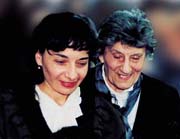  Left: Daughter Fovziya Afandi and wife Bayim
Hajiyeva at Gorkhmaz' exhibition for his 70th Jubilee, May 1999.
Baku. Left: Daughter Fovziya Afandi and wife Bayim
Hajiyeva at Gorkhmaz' exhibition for his 70th Jubilee, May 1999.
Baku.
Gorkhmaz
and Javad laid an alternate path for many young talented artists
to enter the art world. He was keen that his two daughters pursue
art as well. As it turns out, they did. Adila works as an artist
in Vilnius. Fovziya, who went on to study art in Lvov, now works
as an artist in Baku.
From Azerbaijan
International
(7.2) Summer 1999.
© Azerbaijan International 1999. All rights reserved.
Afandiyev | AZgallery Artists
|




 Right:
Fovziya Afandi (Gorkhmaz' daughter) (1963- ), "The Poet
Nasimi", 30 x 90 cm, stained glass, 1987.
Right:
Fovziya Afandi (Gorkhmaz' daughter) (1963- ), "The Poet
Nasimi", 30 x 90 cm, stained glass, 1987.